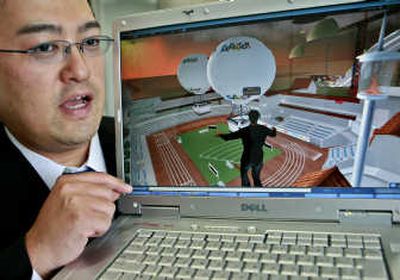A safer ‘Second Life’

TOKYO — Orderly, pornography-free and safe for children, “meet-me,” an online interactive virtual Tokyo, is Japan’s answer to “Second Life.” Or so its creators hope.
Kunimasa Hamaoka, who oversees “meet-me” at digital marketing company Transcosmos Inc., is banking on the cultural differences between Japanese and Americans to compete against the world’s top virtual community.
Japanese are so well-behaved and conformist, he says, they would prefer a more predictable and secure virtual environment over the free-spirited anything-goes of “Second Life,” created by San Francisco-based Linden Lab.
In “meet-me,” players’ avatars, or computer-generated alter-egos, are rounder and softer, more like the cuddly characters of “Pokemon” than the angular and relatively realistic avatars of “Second Life.”
The sun rises and sets in “meet-me” on Tokyo time. And avatars must ride trains or other vehicles or walk or run to get around a city whose streets and buildings look much like real Tokyo’s; they can’t jump from place to place as they can in “Second Life.”
American Internet successes stories have leapt over to Japan with varying results. YouTube, for example, has done fine. But other imports haven’t caught on, opening opportunities for Japanese variations to make it big.
Japan’s social networking service Mixi has attracted 11.1 million people, while the Japanese adaptation of MySpace has enjoyed only moderate success, with fewer than 1.4 million visitors, for example.
But Sony Corp. of Japan, which has a major video game unit, last week delayed until next year the release of “Home,” its entrant in the “metaverse,” or virtual world. Sony President Kazuo Hirai said the PlayStation 3 application needed more work. He didn’t offer a reason for the delay, but PS3 sales are faltering — at 5 million worldwide since it went on sale late last year in Japan and the U.S., and in March in Europe — and that limits the outlook for “Home” from the get-go.
Hamaoka said he is determined to make “meet-me” a strictly Japanese hit, although foreign tourists are welcome visitors.
“This will be a place where people can enjoy themselves with a sense of safety — like Disneyland,” he said.
“There’s total freedom to act in ‘Second Life,’ which requires individual responsibility. It’s very American. Almost everything is OK, including evil.”
In a demonstration, a female “meet-me” avatar in a sedate suit wandered on foot around the Shibuya shopping district, complete with landmarks, including stores and a sculpture of a head, a popular rendezvous spot.
The usually jam-packed streets were still desolate because “meet-me” isn’t open until December.
Once it opens, it will offer cyberspace shopping, entertainment, games and Christmas lights. Visitors will be able to buy virtual plots of land, housing and furnishings — much as in “Second Life.” People also will be able to pick their avatars’ appearance, hairstyle and gender.
Hoping for a million users in its first year, Hamaoka is in talks with dozens of companies, including Shibuya retailers, to set up shop in “meet-me.” But that’s where the similarities to “Second Life” end.
The operation and design of “meet-me” will be strictly controlled by Transcosmos, ensuring law and order and far more policing and filtering to ban profanity than in “Second Life,” which only recently outlawed gambling and is grappling with violations.
“Japanese aren’t going to take to the culture of ‘Second Life,”’ Hamaoka said.
“It’s the kind of place where you can get shot in the back as soon as you log on.”
In fact, avatars can’t die in “Second Life.” But they can use guns. In contrast, Japan has extremely strict gun-control laws, with only the police and the underworld carrying firearms, and guns are rarely seen in public.